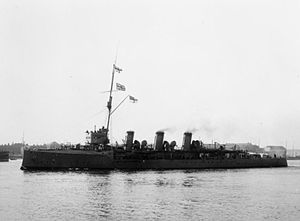HMS Skirmisher (1905)

| |
| History | |
|---|---|
| Name | HMS Skirmisher |
| Builder | Vickers Limited |
| Laid down | July 1903 |
| Launched | 7 February 1905 |
| Commissioned | July 1905 |
| Fate | Sold for scrapping on 3 March 1920 |
| General characteristics | |
| Displacement | 2,880 tons |
| Length | list error: <br /> list (help) 360 ft (110 m) (p/p) 381 ft (116 m) (o/a) |
| Beam | 40 ft (12 m) |
| Draught | 14 ft (4.3 m) |
| Propulsion | list error: <br /> list (help) Two shaft TE engines 17,000 ihp |
| Speed | 25 knots |
| Range | Carried 160 tons coal (410 tons max) |
| Complement | 298 |
| Armament | list error: mixed text and list (help) As built
As modified 1911/12
|
| Armour | list error: <br /> list (help) conning tower: 3 inch deck: 1.5 inch - ⅝ inch |
HMS Skirmisher was one of two Sentinel class scout cruisers which served with the Royal Navy. She was built by Vickers Limited, laid down in July 1903, launched on 7 February 1905 and completed in July 1905 at a cost of about £282,000. She sported a partial turtle deck forward and shorter funnels than later ships of this type. She has been the only ship of the Royal Navy to bear the name Skirmisher.
Career
She was designed to act as a leader of a destroyer flotilla but like other ships of this type was soon proved to be too slow for the role. As turbine engined destroyers came into service, they were rendered obsolete.
HMS Skirmisher began her career as leader of the 5th Destroyer Flotilla of the Home Fleet, based at Dover (1907). She then moved to the 2nd Destroyer Flotilla (1909), 4th Destroyer Flotilla (1910) and finally the 7th Destroyer Flotilla at Portsmouth from July 1913. During her early career, her captains included Walter Cowan and William Boyle, both of whom would later rise to the rank of Admiral.
She began World War I in service with the 7th Destroyer Flotilla based on the Humber, commanding two divisions from the 7th Flotilla (eight torpedo boats), under the overall command of Admiral Ballard, Admiral of Patrols. On 16 December the Germans raided the Yorkshire Coast. When the first news reached him, Ballard put to sea on the Skirmisher, at the head of the flotilla. Heavy seas forced him to send the torpedo boats back to the Humber, but Ballard continued on alone up the Yorkshire coast. By midday he was off Flamborough Head, just south of Scarborough. From there he signalled that there were no ships between him and the Humber (12.40 pm). He then continued north, and was able to report that the enemy had left the vicinity of Whitby and Filey Bay (at the northern and southern ends of the North York Moors), at 9 a.m. and had not been seen since. This signal reached Admiral Beatty at 1.18 p.m., during his unsuccessful attempt to catch the German battlecruisers that had carried out the raid.
In 1915 Skirmisher was temporarily attached to the 6th Light Cruiser Squadron on the Humber. In 1916 she was stationed in the Mediterranean and then the Aegean in 1918. 1920, after the war she was stationed back at Immingham in the Humber until 1920, when she was considered surplus to requirements. On 3 March she was sold for scrap to Ward, of Preston.
References
- Colledge, J. J.; Warlow, Ben (2006) [1969]. Ships of the Royal Navy: The Complete Record of all Fighting Ships of the Royal Navy (Rev. ed.). London: Chatham Publishing. ISBN 978-1-86176-281-8.
- Jane's Fighting Ships of World War One (1919), Jane's Publishing Company
- Sentinel class in World War I
- History of the Sentinel class
